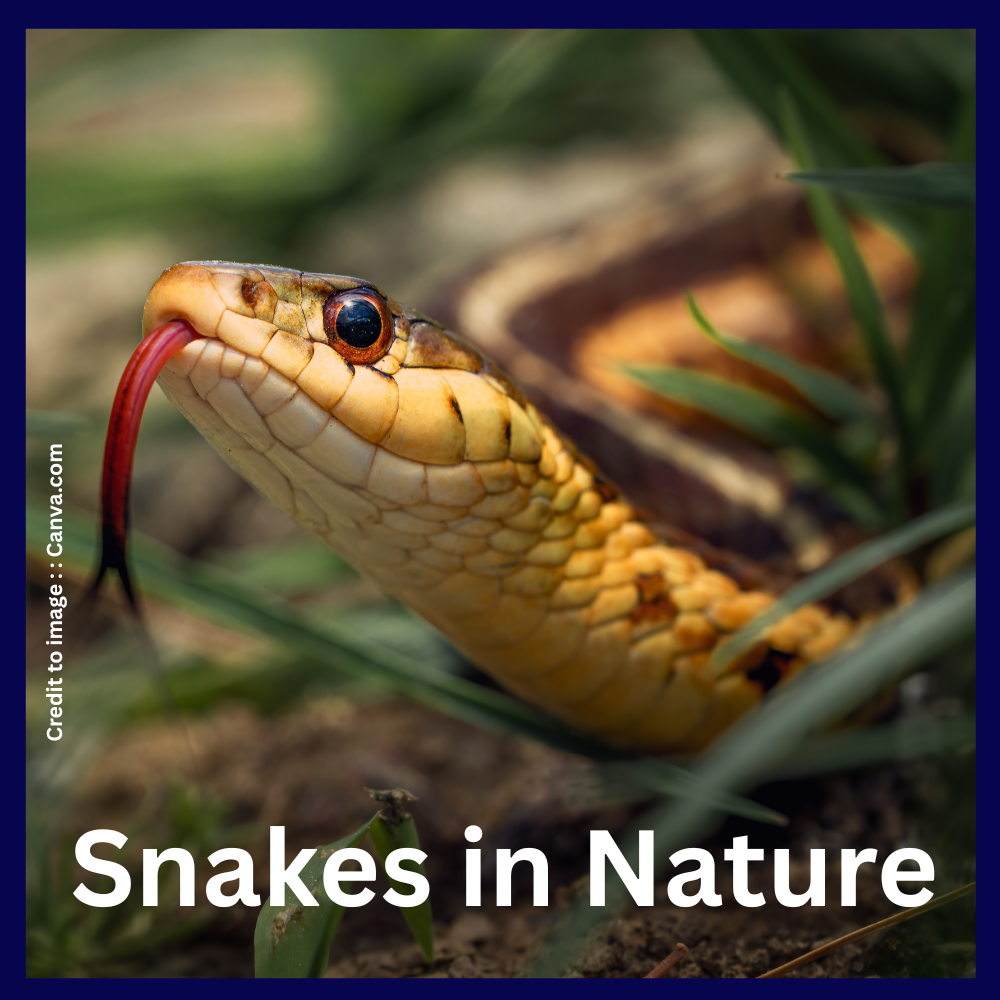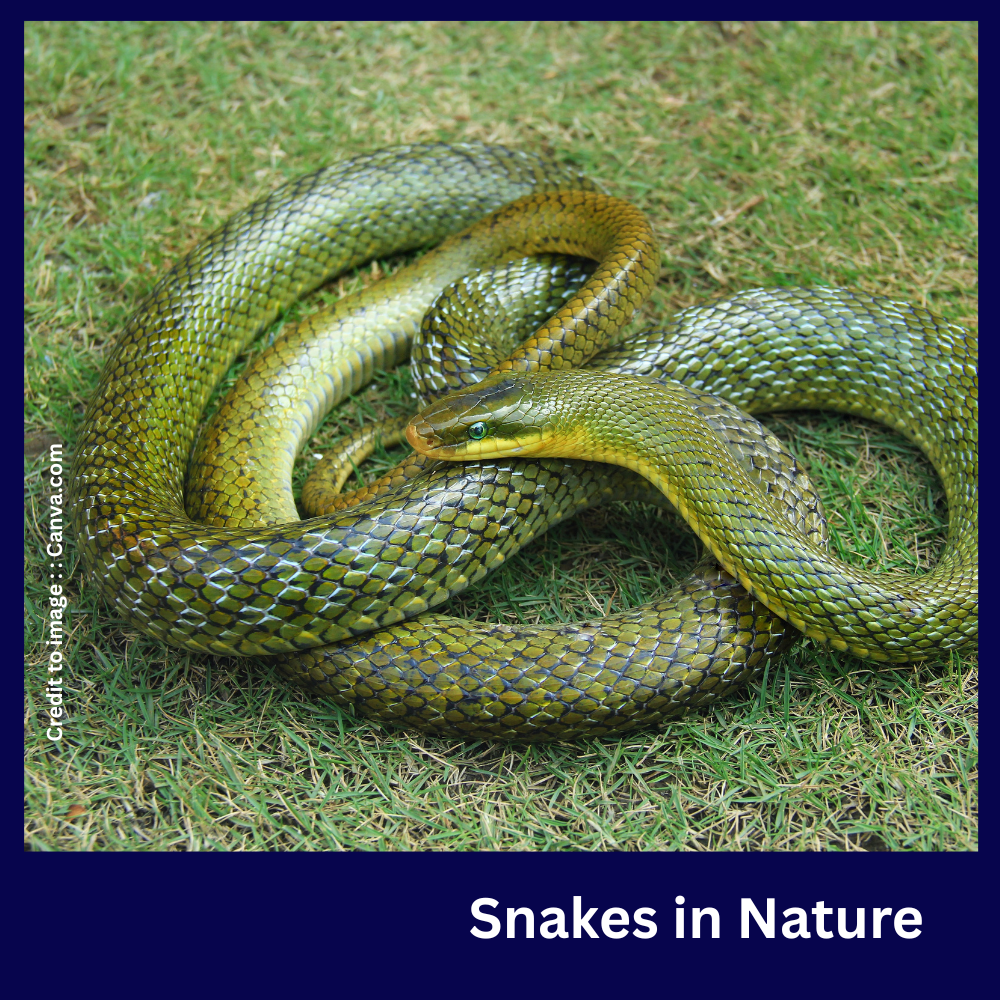Snakes are often feared yet fascinating creatures that hold a vital place in the ecological, agricultural, cultural, and even spiritual fabric of many societies. This article explores snakes from a multidisciplinary perspective, covering their biological diversity, scientific importance, agricultural benefits, role in climate and biodiversity maintenance, religious and mythological significance, and their relevance to achieve the Sustainable Development Goals (SDGs).
Table of Contents
- Introduction
- Scientific Data Table of Snakes
- Species Data Table of Snakes
- Snakes and Agriculture
- Anti-Snake Venom: Research and Application
- How Snakes Benefit Humans
- King Cobra
- Anacondas
- Daboia russelii
- Russell’s Viper
- Python Snake
- Water Snake
- Black Snake
- Other Notable Snake Species
- Country-wise Distribution of Snakes
- Snakes and Biodiversity Conservation
- Role of Snakes in Climate Balance
- Role of Snakes in Achieving SDGs
- Mythology and Cultural Beliefs Around Snakes
- Summary
- Conclusion
- FAQs (15–20)
- References
Introduction of Snakes
Snakes, cold-blooded reptiles of the suborder Serpentes, have slithered through the Earth’s ecosystems for over 100 million years. While their limbless form often inspires fear, snakes are highly evolved predators and ecological indicators. Across different cultures, snakes are revered as powerful symbols of renewal, creation, and sacred energy.Today, with threats from habitat destruction and human conflict, understanding snakes is essential for ecological sustainability.
Scientific Data Table
| Parameter | Details |
| Scientific Order | Squamata |
| Suborder | Serpentes |
| Number of Known Species | ~3,900+ |
| Venomous Species | ~600 |
| Average Lifespan | 9 to 20 years (species-dependent) |
| Longest Recorded Snake | Reticulated Python (~10 meters) |
| Smallest Snake | Barbados Threadsnake (~10 cm) |
Species Data Table of Snakes
| Common Name | Scientific Name | Habitat | Venomous |
| King Cobra | Ophiophagus hannah | Forests | Yes |
| Russell’s Viper | Daboia russelii | Grasslands | Yes |
| Indian Python | Python molurus | Wetlands | No |
| Water Snake | Nerodia spp. | Aquatic | No |
| Black Snake | Pantherophis obsoletus | Forests | No |
| Anaconda | Eunectes spp. | Swamps (S. America) | No |
| Coral Snake | Micrurus spp. | Forests | Yes |
Snakes and Agriculture
Snakes play a crucial role in pest control, preying on rodents that damage crops and spread disease. Farmers in rural India and Africa often protect non-venomous snakes as natural allies in their fields. This ecological pest management reduces dependence on chemical pesticides.
Anti-Snake Venom: Research and Application
Anti-venom is the only effective treatment for venomous snakebites. Countries like India, Brazil, and the USA are leading producers. Innovations in recombinant DNA technology are improving the availability and effectiveness of anti-venoms worldwide.
🐍 How Snakes Benefit Humans & Why are snakes important for the environment?”
Snakes may often be misunderstood or feared, but they play an incredibly important role in supporting human life, ecosystems, agriculture, and even modern medicine. Here’s how snakes contribute to our well-being:
✅ 1. Natural Controllers of Rodent Populations :
Do snakes help in controlling rats naturally?
Snakes serve as highly efficient natural pest regulators, preying on rodents such as rats and mice, which are notorious for:
- Destroy crops
- Contaminate food storage
- Transmit harmful diseases like leptospirosis and hantavirus
By keeping rodent populations in check, snakes help protect agricultural fields, reduce grain loss, and save millions in pest control costs annually.
✅ 2. Source of Anti-Venom and Medical Breakthroughs
How is snake venom used in medicine?
Snake venom isn’t just life-threatening—it’s also life-saving. Medical scientists extract and study specific proteins and enzymes from snake venom for:
- Anti-snake venom production (life-saving for snakebite victims)
- Cancer treatment research (e.g., certain venom peptides target cancer cells)
- Heart disease medication (ACE inhibitors derived from Brazilian pit viper venom)
- Blood clot prevention and painkillers (neurological effects studied from cobra venom)
✅ 3. Cultural, Religious, and Mythological Significance :
Snake in Hindu mythology or Religious importance of snakes :
In many cultures around the world, especially in India, snakes are revered rather than feared:
- Nag Panchami is a festival where snakes are worshipped in Hindu tradition.
- In ancient Egypt and Greece, snakes symbolized rebirth and healing.
- The Rod of Asclepius, a snake-entwined staff, remains a global symbol of medicine.
Such beliefs not only reflect spiritual connections but also encourage the protection of snake habitats.
✅ 4. Indicator Species for Healthy Ecosystems
Snakes are bioindicators—meaning their presence indicates a balanced and healthy environment. A decline in snake populations often signals ecological disruption such as:
- Pollution
- Habitat loss
- Overuse of pesticides
- Imbalanced food chains
Conserving snakes is not just about saving reptiles—it’s about preserving entire ecosystems that humans depend on.
🐍 Famous Snakes Around the World and Their Ecological Roles
Snakes are among the most diverse reptiles on Earth, ranging from venomous hunters to powerful constrictors. Each species contributes uniquely to its habitat, playing vital roles in balancing ecosystems. Let’s explore some of the most famous snake species in the world, their traits, habitats, and ecological importance.
👑 King Cobra – The Longest Venomous Snake in the World
Scientific Name: Ophiophagus hannah
Found In: South and Southeast Asia
Habitat: Forests, swamps, bamboo thickets
The King Cobra is the world’s longest approx. up to 18 feet venomous snake,. Despite its terrifying reputation, this snake rarely attacks unless threatened. What makes it unique:
- Feeds almost exclusively on other snakes, including venomous species.
- Control reptilian populations and play an important role by maintain ecology .
- Its venom affects the nervous system, making it important in neurotoxin studies.
🐊 Anaconda – Giant Constrictor of the Amazon
Scientific Name: Eunectes spp.
Found In: Amazon Rainforest (South America)
Habitat: Swamps, rivers, and wetlands
Anacondas are non-venomous, aquatic boas known for their immense size and power:
- The Green Anaconda holds the title or known for the world’s heaviest snake.
- Uses muscular constriction to suffocate prey.
- Capable of eating large animals like capybaras, birds, wild pigs, and even caimans.
⚠️ Russell’s Viper – A Deadly Snake with Life-Saving Potential
Scientific Name: Daboia russelii
Found In: South Asia (India, Pakistan, Sri Lanka)
Habitat: Grasslands, forests, agricultural areas
The Russell’s Viper is among the “Big Four” venomous snakes in India, responsible for thousands of snakebite incidents annually. However:
- Its venom is critical in producing antivenoms.
- Venom is also used in blood coagulation research.
- Studied for developing new life-saving medications.
This snake’s medical relevance makes it both feared and respected in scientific communities.
🐍 Python – Powerful Constrictor from Asia, Africa, and Australia
Scientific Name: Pythonidae family
Found In: Asia, Africa, Australia
Habitat: Rainforests, savannas, deserts
Pythons are large, non-venomous snakes that kill by constriction:
- Prey on rodents, birds, and mammals, keeping ecosystems balanced.
- Burmese and Indian pythons are crucial for maintaining rodent populations.
- Invasive species in some areas (e.g., Florida Everglades) due to pet trade escapes.
Pythons contribute silently to controlling pests and sustaining local food webs.
🌊 Water Snakes – Guardians of Wetlands
Scientific Name: Varies (Nerodia genus and others)
Found In: North America, Asia, Africa
Habitat: Lakes, ponds, rivers, marshes
Water snakes are frequently misidentified as venomous, though the majority are non-threatening:
• They primarily consume aquatic creatures like frogs, small fish, and water-dwelling rodents.
- Help maintain aquatic ecosystem balance.
- Indicate healthy freshwater habitats due to their sensitivity to pollution.
Common species include Nerodia sipedon (Northern Water Snake) and Checkered Keelback in India.
⚫ Black Snake – A Farmer’s Friend
Scientific Name: Pantherophis obsoletus (Black Rat Snake)
Found In: North America
Habitat: Forests, farmlands, barns
Black snakes, especially the Black Rat Snake, are non-venomous constrictors:
- Known for preying on rats, mice, and small birds.
- Extremely beneficial for farmers by controlling crop-damaging pests.
- Docile and often relocated rather than harmed.
Their presence reflects a healthy rural ecosystem and supports natural pest control.
Snakes as Global Ecological Heroes
From the mighty King Cobra of Asia to the colossal Anaconda of South America, snakes are more than symbols of fear—they are guardians of ecological balance. Some protect crops by eating rodents, while others contribute to life-saving medical research. Recognizing their importance is vital for both conservation and human benefit.
Other Notable Snake Species
- Coral Snakes
- Sea Snakes
- Boomslang
- Hognose Snake
Country-wise Distribution of Snakes
| Country | Approx. Species | Venomous | Conservation Efforts |
| India | 270+ | 60+ | Wildlife Protection Act |
| Brazil | 390+ | 70+ | Amazon Rainforest Preservation |
| Australia | 200+ | 100+ | Strict Environmental Laws |
| USA | 130+ | 20+ | Endangered Species Act |
| Indonesia | 300+ | 50+ | Habitat Restoration Programs |
Snakes and Biodiversity Conservation
Snakes are key in maintaining food web balance. As both predator and prey, they regulate species populations and support biodiversity in forests, wetlands, deserts, and grasslands.
Role of Snakes in Climate Balance
By controlling populations of herbivores like rodents, snakes help preserve vegetation cover, which is essential for carbon capture and mitigating climate change effects.
Role of Snakes in Achieving SDGs
| SDG Goal | Snake Contribution |
| Goal 3: Good Health | Venom used in medicine and anti-venom production |
| Goal 13: Climate Action | Ecosystem stabilization through species control |
| Goal 15: Life on Land | Biodiversity conservation and ecological balance |
| Goal 2: Zero Hunger | Protecting crops by controlling pests |
Mythology and Cultural Beliefs
- Hinduism: Lord Shiva wears a snake; Naag Panchami festival honors snake gods.
- Ancient Egypt: Uraeus (cobra) symbolizes royalty and divine protection.
- Native American Culture: Snakes symbolize healing and transformation.
- Christianity: Snake as a symbol of both temptation and wisdom.
Summary
Snakes, often misunderstood, are ecologically vital, culturally rich, and scientifically valuable. Their conservation is not only necessary for biodiversity but also for sustainable development and public health.
Conclusion:
Understanding snakes beyond fear and superstition reveals their indispensable roles in agriculture, medicine, ecology, and culture. Protecting them is crucial for a balanced environment and achieving global sustainability goals. Snakes quietly support biodiversity, agriculture, cultural identity, and even modern healthcare. Protecting them is not only essential for ecological balance but also aligns with global efforts like the UN Sustainable Development Goals (SDGs), especially:
- Goal 3: Good Health and Well-being
- Goal 13: Climate Action
- Goal 15: Life on Land
FAQs
- Are all snakes venomous?
No, venomous snakes make up only around 15% of all snake species — the majority are completely harmless. - What should I do if I encounter a snake?
Keep calm, avoid any sudden movements or attempts to disturb it, and promptly notify local wildlife officials for safe handling.
- Why are snakes important for farmers?
They control pests like rats and mice naturally. - Can snake venom be used in medicine?
Yes, it’s used in research for cancer, blood pressure, and pain relief. - Which snake holds the title of the world’s most venomous?
The Inland Taipan, also known as the “fierce snake,” is considered the most venomous snake on Earth due to its extremely potent venom.
- What is anti-venom?
A serum used to counteract venom from a snakebite. - How do snakes contribute to biodiversity?
They maintain the balance of ecology by balancing prey and predator species. - Which Indian festival celebrates snakes?
Naag Panchami. - What is the lifespan of a snake?
Lifespan of snakes 9–20 years depending on the species. - Are pythons dangerous?
They are non-venomous. Can be dangerous due to their size etc.
FAQs
- Do snakes live in water?
Yes, many species live in water like water snakes and sea snakes . - Can snakes be kept as pets?
Yes, in some countries and with proper licenses. - Why do some snakes spit venom?
To defend themselves from predators (e.g., spitting cobras). - How are snakes affected by climate change?
Habitat loss and temperature shifts affect their survival. - Do snakes have ears?
They don’t have external ears. But they can sense vibrations etc . - What’s the difference between venomous and poisonous?
Venomous injects toxin (bite/sting); poisonous is harmful if ingested. - Which countries have the most snake species?
Brazil, India, Indonesia, and Australia. - How many types of cobras exist?
There are over 20 species of cobras globally. - Is black snake venomous?
Most are non-venomous and beneficial. - Why are snakes worshipped in Hinduism?
They are symbols of power, protection, and rebirth.
References
- World Health Organization: Snakebite Envenoming Fact Sheet
- IUCN Red List of Threatened Species
- National Geographic Snake Database
- Indian Wildlife Protection Act, 1972
- Scientific Journals on Herpetology (Journal of Venom Research, Herpetologica)
- UN Sustainable Development Goals Reports
PRAKRITI DARSHAN-NATURE AND ENVIRONMENT MAGAZINE
Prakriti Darshan is a leading Hindi-language magazine and digital platform dedicated to raising public awareness on vital issues related to nature, biodiversity, climate change, sustainable development, and environmental conservation. This magazine represents a unique blend of science, society, and sensitivity—offering a common platform for researchers, students, NGOs, policymakers, nature lovers, and conscious citizens alike.
With thought-provoking articles, inspiring stories, environmental research, impactful projects, and policy perspectives, Prakriti Darshan is a transformative journey toward a greener and more sustainable future.
Let us come together to protect and preserve our planet for generations to come. 🌿🌍
Join us in our mission to protect and celebrate the planet. 🌏💚
Click for more information
- Visit www.prakritidarshan.com for Free Magazine ,Free membership benefits ,offered price magazine @ Rs.1 or Rs.11 only and more ……
- 🎗️Sponsor Prakriti Darshan Magazine – Support our environment mission.
- 📚 Explore the Environment Magazine – Read our latest and past issues.
- ✍️ Read Editor’s Article or Blog – Insightful thoughts from our editorial desk.
- 🌱 Join Membership – Be part of India’s leading green community.
- 🤝 Become an NGO Impact Story Partner – Share your grassroots impact nationwide.
- 🏢 Become a Company Partner – Showcase your CSR, ESG, or sustainability work.
- 👤 Become an Individual Partner – Volunteer, write, and raise your green voice.
- 📢 Advertise with Us – Reach eco-conscious readers across India.
- Eco Trails Newsletter
- Donate for “Hari Ho Vashundhara & Har school Hariyali “ Plantation campaign Associated Partner NGO :GDSS NGO www.gdssngo.org
BALA DATT SHARMA,
MANAGING EDITOR ,
PRAKRITI DARSHAN-NATURE AND ENVIRONMENT MAGAZINE
- Indoor Plants – Money Plants – Benefits, Care & Top 15 Plants with Special Focus on Money Plants - September 12, 2025
- Sunflower and Its Role in Climate: A Comprehensive Study on Uses, Benefits, and Global Importance - September 12, 2025
- Endangered Species USA – Conservation Challenges, Data, and Future of Wildlife - September 11, 2025







